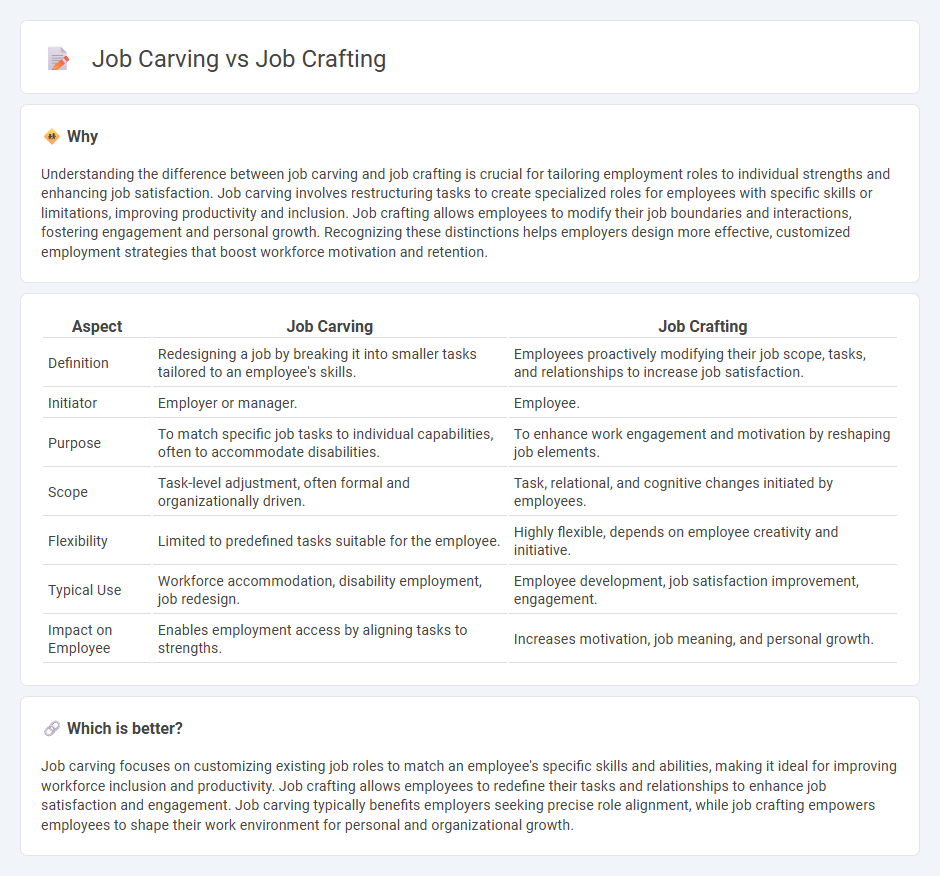
Job carving focuses on redesigning existing job roles to match the specific skills and abilities of employees, often benefiting those with disabilities by tailoring tasks to their strengths. Job crafting allows employees to proactively modify their job scope, relationships, and perceptions to better align with their interests and motivations, enhancing job satisfaction and performance. Explore the distinctions and applications of job carving and job crafting to improve workforce engagement and productivity.
Why it is important
Understanding the difference between job carving and job crafting is crucial for tailoring employment roles to individual strengths and enhancing job satisfaction. Job carving involves restructuring tasks to create specialized roles for employees with specific skills or limitations, improving productivity and inclusion. Job crafting allows employees to modify their job boundaries and interactions, fostering engagement and personal growth. Recognizing these distinctions helps employers design more effective, customized employment strategies that boost workforce motivation and retention.
Comparison Table
| Aspect | Job Carving | Job Crafting |
|---|---|---|
| Definition | Redesigning a job by breaking it into smaller tasks tailored to an employee's skills. | Employees proactively modifying their job scope, tasks, and relationships to increase job satisfaction. |
| Initiator | Employer or manager. | Employee. |
| Purpose | To match specific job tasks to individual capabilities, often to accommodate disabilities. | To enhance work engagement and motivation by reshaping job elements. |
| Scope | Task-level adjustment, often formal and organizationally driven. | Task, relational, and cognitive changes initiated by employees. |
| Flexibility | Limited to predefined tasks suitable for the employee. | Highly flexible, depends on employee creativity and initiative. |
| Typical Use | Workforce accommodation, disability employment, job redesign. | Employee development, job satisfaction improvement, engagement. |
| Impact on Employee | Enables employment access by aligning tasks to strengths. | Increases motivation, job meaning, and personal growth. |
Which is better?
Job carving focuses on customizing existing job roles to match an employee's specific skills and abilities, making it ideal for improving workforce inclusion and productivity. Job crafting allows employees to redefine their tasks and relationships to enhance job satisfaction and engagement. Job carving typically benefits employers seeking precise role alignment, while job crafting empowers employees to shape their work environment for personal and organizational growth.
Connection
Job carving and job crafting both focus on customizing work roles to enhance employee satisfaction and productivity by aligning tasks with individual strengths and preferences. Job carving involves the intentional restructuring of job duties to fit a worker's specific skills, often creating new roles for employees with disabilities. Job crafting allows employees to proactively modify their existing tasks, relationships, and perceptions to better suit their interests and improve engagement.
Key Terms
Personalization
Job crafting involves employees proactively modifying their job tasks, relationships, and perceptions to better align with their strengths, passions, and values, fostering enhanced engagement and satisfaction. Job carving, a subset of job crafting, focuses on restructuring specific duties within a role to fit an individual's capabilities, often used to accommodate diverse workforce needs or disabilities. Explore how customizing job roles through crafting and carving can boost productivity and employee wellbeing.
Role modification
Job crafting involves employees proactively altering their job roles by reshaping tasks, relationships, and perceptions to better align with their strengths and interests. Job carving, a targeted approach, focuses on redesigning specific job duties to accommodate individual capabilities, often in inclusion or disability employment contexts. Explore detailed strategies on role modification in job crafting and job carving to enhance workplace satisfaction and productivity.
Task restructuring
Job crafting involves employees proactively reshaping their tasks and interactions to better align with personal strengths and interests, enhancing job satisfaction and performance. Job carving is a targeted process where tasks are specifically reallocated or redefined to create a new role or adjust existing roles, often to accommodate individual capabilities or organizational needs. Explore how task restructuring through job crafting and carving can optimize workforce engagement and productivity.
Source and External Links
Job crafting - Wikipedia - Job crafting involves self-initiated, proactive strategies to change job characteristics, such as task, relational, and cognitive crafting.
Job Crafting: What HR Professionals Need to Know - AIHR - Job crafting allows individuals to make changes to their tasks, develop skills, craft purpose, build relationships, and enhance well-being to tailor their job for personal fit.
Job Crafting LLC: Job Crafting Store - The Job Crafting Exercise is a tool that helps optimize job design for happiness and effectiveness by aligning work with personal values, strengths, and passions.
 dowidth.com
dowidth.com